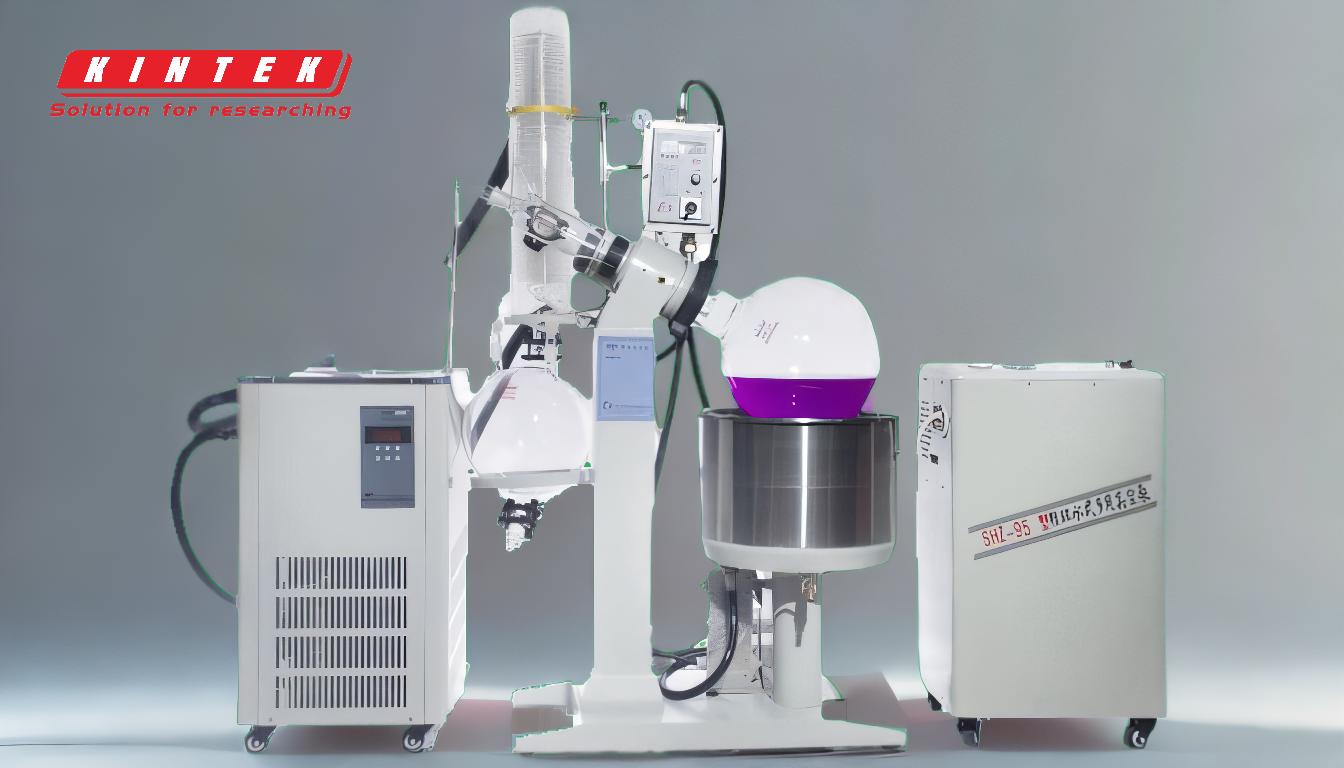Yes, a rotary evaporator can effectively remove water from a mixture or solution. This process is achieved by leveraging the principles of reduced pressure, controlled heating, and increased surface area through rotation. The rotary evaporator is a versatile piece of equipment commonly used in laboratories and industrial settings for tasks such as solvent removal, concentration of solutions, and purification of substances. By lowering the boiling point of water through vacuum application and optimizing evaporation conditions, water can be efficiently separated from other components in the mixture.
Key Points Explained:

-
Working Principle of a Rotary Evaporator:
- A rotary evaporator operates by reducing the pressure inside the system using a vacuum pump. This lowers the boiling point of the solvent (in this case, water), allowing it to evaporate at a lower temperature.
- The sample is placed in a rotating flask, which increases the surface area of the liquid, promoting faster evaporation.
- A heated water bath provides controlled thermal energy to accelerate the evaporation process.
- The evaporated solvent (water) is then condensed back into liquid form in a condenser and collected in a separate flask.
-
Steps to Remove Water Using a Rotary Evaporator:
- Preparation: Fill the distilling flask to no more than 50% of its capacity to prevent spillage during rotation.
- Set Temperature: Heat the water bath to a temperature slightly above the boiling point of water under reduced pressure (typically 30-40°C).
- Adjust Vacuum: Apply a vacuum to lower the pressure, which reduces the boiling point of water.
- Rotation Speed: Set the flask rotation speed to 150-200 rpm to create a thin film of the liquid, enhancing evaporation.
- Condenser Cooling: Maintain the condenser temperature between -10°C and 0°C to ensure efficient condensation of the evaporated water.
-
Advantages of Using a Rotary Evaporator for Water Removal:
- Efficiency: The combination of reduced pressure, rotation, and heating allows for rapid and efficient water removal.
- Gentle Process: The lower boiling point under vacuum minimizes the risk of thermal degradation of heat-sensitive materials.
- Versatility: Suitable for a wide range of applications, from laboratory research to industrial processes, such as concentrating fruit juice or purifying chemical compounds.
-
Applications of Water Removal Using a Rotary Evaporator:
- Food Industry: Concentrating fruit juices or extracts by removing water to enhance flavor and shelf life.
- Chemical Laboratories: Isolating or purifying compounds by separating water from mixtures.
- Pharmaceuticals: Concentrating active ingredients or removing water from solutions to achieve desired formulations.
-
Factors Influencing Water Removal Efficiency:
- Vacuum Strength: A stronger vacuum lowers the boiling point further, enabling faster evaporation.
- Temperature Control: Precise heating ensures optimal evaporation without overheating the sample.
- Rotation Speed: Faster rotation increases the surface area, improving evaporation rates.
- Sample Composition: The presence of other solvents (e.g., ethanol) can affect the boiling point and evaporation dynamics.
-
Practical Tips for Effective Water Removal:
- Monitor the Process: Regularly check the distillate collection flask to ensure water is being removed as expected.
- Adjust Parameters: Fine-tune the temperature, vacuum, and rotation speed based on the specific sample and desired outcome.
- Safety Precautions: Ensure proper sealing of the system to maintain vacuum integrity and prevent leaks.
-
Comparison with Other Methods:
- Rotary Evaporator vs. Simple Distillation: Rotary evaporation is faster and more efficient due to the combined effects of rotation, vacuum, and heating.
- Rotary Evaporator vs. Freeze Drying: While freeze drying is excellent for preserving heat-sensitive materials, rotary evaporation is more suitable for quick water removal in non-sensitive applications.
By understanding these key points, users can effectively utilize a rotary evaporator to remove water from mixtures, ensuring optimal results for their specific applications.
Summary Table:
| Key Aspect | Details |
|---|---|
| Working Principle | Reduces pressure, lowers boiling point, and increases surface area via rotation. |
| Steps for Water Removal | Prep flask, set temperature, adjust vacuum, rotate flask, cool condenser. |
| Advantages | High efficiency, gentle process, versatile for various applications. |
| Applications | Food industry, chemical labs, pharmaceuticals. |
| Efficiency Factors | Vacuum strength, temperature control, rotation speed, sample composition. |
| Practical Tips | Monitor process, adjust parameters, ensure safety. |
| Comparison with Other Methods | Faster than simple distillation; quicker than freeze drying for water removal. |
Discover how a rotary evaporator can streamline your water removal process—contact our experts today!









